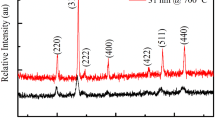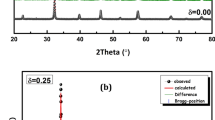Abstract
Electrical properties of natural alexandrite (BeAl2O4:Cr3+) are investigated by the thermally stimulated depolarization current (TSDC) technique. Samples are submitted to consecutive annealing processes and TSDC is carried out after each annealing, yielding bands with different parameters. These bands are fitted by a continuous distribution of relaxation parameters: activation energy and pre-exponential factor of the Arrhenius equation. It has been observed that annealing influences the dipole relaxation behavior, since it promotes a modification of Fe3+ and Cr3+ impurity distributions on sites of distinct symmetry: Al1 and Al2. In order to have a reference for comparison, TSDC is also carried out on a synthetic alexandrite sample, where the only impurity present is Cr3+ ion.



Similar content being viewed by others
References
Barry WR, Troup GJ (1969) EPR of Cr3+ ions in alexandrite. Phys Stat Sol 35:861–864
Braunlich P (1979) Topics in applied physics: (37) Thermally stimulated relaxation in solids. Springer, Berlin Heidelberg New York
Bucci C, Fieschi R, Guidi G (1966) Ionic thermocurrents in dielectrics. Phys Rev 148:816–823
Farrel EF, Fang JH, Newhom RE (1963) Refinement of the chrysoberil structure. Am Mineral 48:804–810
Ferreira GFL, Figueiredo MT, Fedosov SN, Giacometti JA (1998) Thermally stimulated polarization in dye doped polystyrene explained via the Williams–Watts α–β relaxation model. J Phys D:Appl Phys 31:2051
Forbes CE (1983) Analysis of the spin hamiltonian parameters for Cr3+ in mirror and inversion symmetry sites of alexandrite (Al2-xCrxBeO4). Determination of the relative site occupancy by EPR. J Chem Phys 79:2590
Havriliak S, Negami S (1967) A complex plane representation of dielectric and mechanical relaxation processes in some polymers. Polymer 8:161
Kalogeras IM, Vassilikou-Dova A, Katerinopoulou A (2002) Axially dependent dielectric relaxation response of natural hydroxyapatite single crystals. J Appl Phys 92:406–414
Liu J, Tang R, Wang Y, Jia W, Shang Y, He S (1988) The fluorescence spectrum of chrysoberyl BeAl2O4:Cr3+ at high pressure and low temperature. J Lumin 40–41:419–420
Powell RC, Xi L, Gang X, Quarles GJ (1985) Spectroscopic properties of alexandrite crystals. Phys Rev B 32:2788–2797
Rabadanov MK, Dudka AP (1997) Comparative structural study of Al2BeO4 and Al2BeO4:Cr3+. Inorg Mater 33:48
Rager H, Bahshandh-Khiri A, Schmetzer KN (1998) Investigation of the intracrystalline Cr3+ distribution in natural and synthetic alexandrites. N Jb Miner Mh 2:545–557
Scalvi LVA, Oliveira L, Minami E, Siu Li M (1993) Dipole relaxation current in n-type AlxGa1-xAs. Appl Phys Lett 63:2658–2660
Scalvi LVA, Oliveira L, Siu Li M (1995) Light-induced relaxing dipoles in n-type AlxGa1-xAs. Phys Rev B 51:13864–13867
Scalvi RMF, Siu Li M, Ruggiero LO, Scalvi LVA (2001) Light-induced electric dipole relaxation in synthetic and natural alexandrite. Radiat Eff Defects Solids 156:295–299
Scalvi RMF, Ruggiero LO, Siu Li M (2002) Influence of annealing on X-ray diffraction of natural alexandrite. Powder Diffr 17:135–138
Scalvi RMF, Siu Li M, Scalvi LVA (2003) Annealing effects on optical properties of natural alexandrite. J Phys: Condens Matter 15:7437–7443
Schmetzer K, Bank H, Gubelin E (1980) The alexandrite effect in minerals: Chrysoberyl, Garnet, Corundum, Fluorite. N Jb Miner Abh 138:147–164
Shepler KL (1984) Fluorescence of inversion site Cr3+ ions in alexandrite. J Appl Phys 56:1314
Yeom TH, Lim AR, Choh SH, Hong KS, Yu YM (1995) Temperature dependent nuclear magnetic resonance study of 9Be in an alexandrite single crystal. J Phys: Condens Matter 7:6117–6123
Acknowledgments
The authors wish to thank Prof. Tomaz Catunda for providing the synthetic sample and Brazilian financial supporting agencies: CAPES, CNPq, FUNDUNESP, FAPESP and MCT-PRONEX.
Author information
Authors and Affiliations
Corresponding author
Rights and permissions
About this article
Cite this article
Scalvi, R.M.F., Li, M.S. & Scalvi, L.V.A. Thermal annealing-induced electric dipole relaxation in natural alexandrite. Phys Chem Minerals 31, 733–737 (2005). https://doi.org/10.1007/s00269-004-0442-7
Received:
Accepted:
Published:
Issue Date:
DOI: https://doi.org/10.1007/s00269-004-0442-7




